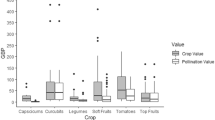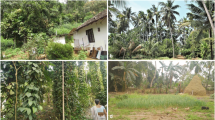Abstract
Dzalanyama Forest Reserve covering 935 km2 is marked with substantial land cover transitions. The objective of this study was to simulate, using multi-agent simulation model, the cropping decisions and a competing labour practice (charcoal production) by smallholder farmers surrounding the forest reserve. The results show close similarities with observed trends between 1990 and 2010. Food deficiency in the smallholder farming system is the major driving factor to deforestation and the future looks bleak in the scenario of business as usual (S1). An increased reward from the scenario of formalized charcoal sector (S2) shows a positive and sustainable trend to control the deforestation. It predicts a reduction in forest loss than in S1 equivalent to an accumulated gain of forest cover of 4 % in 2030. Despite there being a complex pathway to achieving formalization of the charcoal sector in the area in reality, we build on its reported success elsewhere in sub-Saharan Africa to test its effect on deforestation. From S2 we extrapolate that, with ‘private taxes’ diverted into formal revenue, the accruing revenue to both charcoal producers and government would be increased. More revenue allows for rules on efficient and effective charcoal production to be enforced, allowing charcoal producers to make more charcoal from less wood stocks. More charcoal means increased revenue to the households that has the potential to increase crop production while less wood stocks imply fewer trees felled. Either way, a formal charcoal sector of S2 serves to suggest reduced deforestation in the long term.











Similar content being viewed by others
References
Auyung, S. Y. (1998). Foundations of complex-systems theories in economics, evolutionary biology, and statistical physics. Cambridge: Cambridge University Press.
Berger, T. (2001). Agent-based spatial models applied to agriculture: A simulation tool for technology diffusion, resource use changes and policy analysis. Agricultural Economics, 25(2–3), 45–260.
Bonabeau, E. (2002). Agent-based modelling: Methods and techniques for simulating human systems. Proceedings of the National Academy of Sciences, 9(3), 7280–7287.
Boscolo, M., Whiteman, A., Savenije, H., van Dijk, S. (2008). Forestry Policy Brief: Financing sustainable forest management. http://www.fao.org/forestry/en/ Accessed 1 Aug 2013.
Bryceson, D. F. (2006). Ganyu casual labour, famine and HIV/AIDS in rural Malawi: Causality and casualty. Journal of Modern African Studies, 44(2), 173–202.
Chidumayo, E. N., & Gumbo, D. J. (2013). The environmental impacts of charcoal production in tropical ecosystems of the world: A synthesis. Energy for Sustainable Development, 17(2), 86–94.
Deadman, P., Robinson, D., Moran, E., & Brondizo, E. (2004). Colonist household decision-making and land-use change in the Amazon Rainforest: An agent based simulation. Environment and Planning B, 31(5), 693–709.
Delgado, C. L. (1997). The role of smallholder income generation from agriculture in sub-Saharan Africa. In L. Haddad (Ed.), Achieving food security in Southern Africa: New challenges, new opportunities (pp. 145–173). Washington: International Food Policy Research Institute.
Grimm, V., Berger, U., DeAngelis, D. L., Polhill, J. G., Giske, J., & Railsback, S. F. (2010). The ODD protocol: A review and first update. Ecological Modeling, 221(23), 2760–2768.
Grimm, V., Berger, U., et al. (2006). A standard protocol for describing individual-based and agent-based models. Ecological Modeling, 198(1), 115–126.
Kambewa, P. S., Mataya, B. F., Sichinga, W. K., & Johnson, T. R. (2007). Charcoal: the reality—A study of charcoal consumption, trade and production in Malawi. London: International Institute for Environment and Development.
Macmillan, W., & Huang, H. Q. (2008). An agent-based simulation model of primitive agricultural society. Geoforum, 39(2), 643–658.
Malawi Government. (1998). Malawi population census. Zomba: National Statistical Office.
Malawi Government. (2002). Malawi national land policy. Lilongwe: Ministry of Lands, Physical Planning and Surveys.
Malawi Government. (2005). Food security monitoring report, Malawi. Lilongwe: Malawi Vulnerability Assessment Committee.
Malawi Government. (2006). Lilongwe district socio-economic profile. Lilongwe: Lilongwe District Assembly.
Map Comparison Kit. (2012). Map comparison kit 3 user manual. Maastricht: Research Institute for Knowledge Systems BV.
Munthali, K. G., & Murayama, Y. (2011). Land-use/cover change detection and analysis for Dzalanyama forest reserve, Lilongwe, Malawi. Procedia Social and Behavioral Sciences, 21, 203–211.
Munthali, K. G., & Murayama, Y. (2012). Extending agent-based land-use/-cover change models to tropical deforestation: a focus on farm-based decision making in tropical subsistence farming. International Journal of Geographical Information Science, 26(10), 1881–1895.
Munthali, K. G., & Murayama, Y. (2013). Interdependences between smallholder farming and environmental management in rural Malawi: A case of agriculture-Induced environmental degradation in Malingunde Extension Planning Area (EPA). Land, 2(2), 158–175.
Mvula, P. M., Chirwa, E. W., & Kadzandira, J. (2003). Poverty and social impact assessment in Malawi: closure of ADMARC markets. Zomba: Wadonda Consult and World Bank.
Mwampamba, T. H., Ghilardi, A., Sander, K., & Chaixe, K. J. (2013). Dispelling common misconceptions to improve attitudes and policy outlook on charcoal in developing countries. Energy for Sustainable Development, 17(2), 75–85.
Mwaniki, A. (2006). Achieving food security in Africa: Challenges and Issues. http://www.un.org/africa/osaa/reports.html. Accessed 30 July 2013.
Parker, D. C., Manson, S. M., Janssen, M. A., Hoffman, M. J., & Deadman, P. (2003). Multi-agent systems for the simulation of land-use and land-cover change: a review. Annals of the Association of American Geographers, 93(2), 314–337.
Pontius, R. G., & Millones, M. (2011). Death to Kappa: Birth of quantity disagreement and allocation disagreement for accuracy assessment. International Journal of Remote Sensing, 32(15), 4407–4429.
Rajan, K. S., Shibasaki, R. (2000). A GIS based integrated land-use/cover change model to study human–land interactions. International Archives of Photogrammetry, Remote Sensing and Spatial Information Sciences, 13, Part B7.
Repast (2012). The Repast Suite. http://repast.sourceforge.net/index.html. Accessed 21 Dec 2012.
Schure, J., Ingram, V., Sakho-Jimbira, M. S., Levang, P., & Wiersum, K. F. (2013). Formalisation of charcoal value chains and livelihood outcomes in Central- and West Africa. Energy for Sustainable Development, 17(2), 95–105.
Sulistyawati, E., Noble, I. R., & Roderick, M. L. (2005). A simulation model to study land-use strategies in swidden agriculture systems. Agricultural Systems, 85(3), 271–288.
van Vliet, J., Bregt, A. K., & Hagen-Zanker, A. (2011). Revisiting Kappa to account for change in the accuracy assessment of land-use change models. Ecological Modelling, 222(2), 1367–1375.
Wada, Y., Rajan, K. S., & Shibasaki, R. (2007). Modelling the spatial distribution of shifting cultivation in Luangprabang, Lao PDR. Environment and Planning B, 34(3), 261–278.
World Agroforestry Centre. (2008). Farming trees, banishing hunger: How an agroforestry programme is helping smallholders in Malawi to grow more food and improve their livelihoods. Nairobi: World Agroforestry Centre.
Zulu, L. C., & Richardson, R. B. (2013). Charcoal, livelihoods, and poverty reduction: Evidence from sub-Saharan Africa. Energy for Sustainable Development, 17(2), 127–137.
Acknowledgments
We thank the Japanese Government through the Ministry of Education, Culture, Sports, Science and Technology (MEXT) for funding this study. We also thank the Agriculture Extension Development Coordinator (Douglas Malasa), his staff, and farmers of Malingunde EPA in Lilongwe ADD, Malawi for the positive response and support during data collection.
Author information
Authors and Affiliations
Corresponding author
Rights and permissions
About this article
Cite this article
Munthali, K.G., Murayama, Y. Modeling deforestation in Dzalanyama Forest Reserve, Lilongwe, Malawi: a multi-agent simulation approach. GeoJournal 80, 743–757 (2015). https://doi.org/10.1007/s10708-014-9592-4
Published:
Issue Date:
DOI: https://doi.org/10.1007/s10708-014-9592-4




